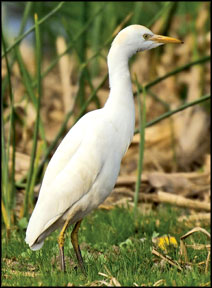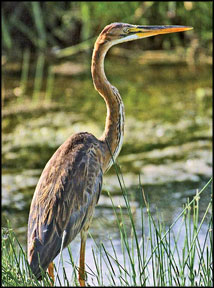
A wealth of Wildlife
Nilma DOLE
|

Cattle Egret |
Being one of the small luxury hotels in the world, the secret to
Jetwing's 'Vil Uyana' is definitely its vibrant and astounding wildlife.
Tucked comfortably just a few kilometres from the 'World's 8th Wonder'
Sigiriya's Lion rock fortress, 'Vil Uyana' is one of the world's first
hotels to construct a wetland system to create its very own nature
reserve. Nearly 30 species of birds of which 16 are endemic and about 40
species of dragonflies and butterflies call 'Vil Uyana' home.
|

Purple Heron |
The fabulous resort is primarily revolved on a very sustainable
eco-tourism concept where wildlife live in harmony with the visitors.
The Resident Manager Priyanthika Wijenayake said, "We have built 'Vil
Uyana' to live in harmony with nature as you can see at the restaurant
that birds roost in the ceiling and they provide entertainment to our
visitors". This is definitely the case as you can see some 'friendly'
birds inviting themselves to sit on your lounge chairs and helping them
to your meal. It was supposedly an arduous task of converting the dry
zone 'chena' lands formed by the previously used 'slash and burn'
agriculture method, to a seasonal wetland (land that is inundated by
water for part of the year). Eventually, the resorts' architects worked
tirelessly to plant reeds, new groves of trees and human-made lakes with
an organic garden that attracted a wealth of wildlife. Set amidst 5
acres of fertile land, the resort has a sustainable mechanism of
conserving energy and using traditional local nature-friendly products.
An in-house naturalist team also monitors and researches the development
of wildlife and ecosystems through a research centre, integrated into
the hotel. The research centre also has a library, a room for laboratory
based work and a computer room and every visitor is a nature
conservationist. The environmental awareness at 'Vil Uyana' is the focal
point which is part and parcel of Jetwing's responsibility towards
nature conservation and the 'Jetwing Eternal Earth project' is
championing the fact that we need to grow more trees in an attempt to
minimize the impact of climate change. Waking up to a beautiful new day,
we took a nature trek in the wee hours of the morning where our nature
guide Sujith showed us the multitude of brilliant and dazzling bird life
at 'Vil Uyana'. Here are some of the wonderful avifauna we witnessed.
|

Crimson-backed flameback |
Birds at 'Vil Uyana'
H Ceylon Green bee-eater - The Ceylon Green-tailed Bee-eater is
migratory brightly-coloured and slender bird which is predominantly
green. Its face has a narrow blue patch with a black eye stripe, and a
yellow and brown throat; the tail is blue and the beak is black. It can
reach a length of 23-26 cm, including the two elongated central tail
feathers. This is a bird which breeds in sub-tropical open country, such
as farmland, parks or paddy fields and lives near water eating insects,
bees, wasps and hornets. These bee-eaters are gregarious, nesting
colonially in sandy banks or open flat areas. They make a relatively
long tunnel in which the 5 to 7 spherical white eggs are laid. Both the
male and the female take care of the eggs. These birds also feed and
roost communally. Their call is a distinctive shrill.
|

Green Bee eaters |
H Ceylon Scimitar-Babbler - The Sri Lanka Scimitar-babbler (Pomatorhinus
melanurus) is related to the Indian Scimitar-babbler being an Old World
babbler found in Sri Lanka's forest habitats. They are more easily
identified by the distinctive call made by pairs or small groups and can
be hard to spot as they forage through dense vegetation. The long
yellow, scimitar-shaped bills are distinctive and give them their name.
It is part of the White-browed Scimitar-babbler species and is connected
to the mainland Indian species. The most distinctive feature of this
22cm long bird is the long down-curved yellow bill which is blackish at
the base of the upper mandible. It has a striking head pattern, with a
long white speculum above a broad black band through the eye. The white
throat and breast contrast with the dark grayish brown on the upper side
and dark gray to black on most of the underside. The tail is broad, long
and graduated. They have short, round wings and being weak fliers are
rarely seen flying in the open.
H Cattle Egret - The Cattle Egret (Bubulcus ibis) is a cosmopolitan
species of heron (family 'Ardeidae') found in the tropics, subtropics
and warm temperate zones. Being a stocky white bird, it is adorned with
buff plumes in the breeding season and it nests in colonies, usually
water and often with other wading birds. Unlike most other herons, it
feeds in relatively dry grassy habitats, usually accompanying cattle or
other large mammals, since it catches insect and small vertebrate prey
disturbed by these animals. Some populations of the Cattle Egret are
migratory and others show post-breeding dispersal. The adult Cattle
Egret has few predators, but birds or mammals may raid its nests, and
chicks may be lost to starvation, calcium deficiency or disturbance from
other large birds. This species removes ticks and flies from cattle, but
it can be a safety hazard at airfields, and has been implicated in the
spread of tick-borne animal diseases.
H Great Egret - The Great Egret (Ardea alba), also known as the Great
White Egret or Common Egret or (now not in use) Great White Heron, and
called 'kotuku' in New Zealand, is a large egret. Distributed across
most of the tropical and warmer temperate regions of the world, in
Southern Europe and Asia it is rather localized. It is sometimes
confused with the Great White Heron in Florida, which is a white morph
of the closely related Great Blue Heron (A. herodias). Note however that
the name Great White Heron has occasionally been used to refer to the
Great Egret.
H Crimson-backed flameback - The Sri Lankan Crimson-backed flameback
has very dark and rufous wings and a dark hindneck which is sometimes
considered a Greater Flameback subspecies (C. l. stricklandi), often
distinguished as a distinct species. The Greater Flameback is a large
woodpecker, at 33 cm in length being of typical woodpecker shape, having
an erect crest and a long neck. Coloration is highly variable between
subspecies; it always has unmarked golden-yellow to dark brown back and
wings. The rump is red and the tail is black. The underparts are white
with dark markings (chevrons, stripes, or bands), or light brown. The
head is whitish with a black pattern, or it is yellow, brown or red. The
straight pointed bill is long (longer than the head) and - like the legs
and four-toed zygodactyls feet (two toes pointing forward, two backward)
- lead-gray. The eyes' irides are whitish to yellow. |



